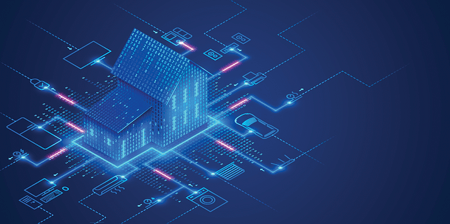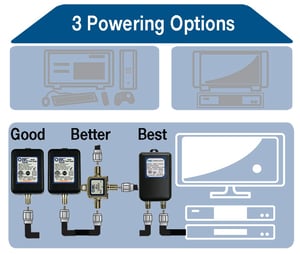
No two homes are built the same, which means a TV and Internet service provider technician never quite knows what they’re getting into until they arrive at an installation.
Experienced technicians will of course be prepared for all types of issues, the first of which will be to identify where to plug in the power source for an amplifier.
In this blog post we explore the three most common types of installations for powering a house amplifier and we offer our own recommendation for the best solution to cover any situation.
Installation Option 1: Electrical Outlet Near the Amplifier (Dedicated Port)
The most convenient scenario for installing an amplifier is to have an electrical outlet within a few feet of the amplifier installation location. In this situation, a technician will then simply be able to plug a standard power supply into the outlet and connect the power supply to the dedicated power port of the amplifier using a short coax cable jumper. This is a great solution when an electrical outlet is close by, however technicians often come across more challenging scenarios when they're out in the field.
Problems can arise for example when the amplifier is located too far from an electrical outlet. Running a 50-foot cable to the opposite side of the garage isn’t always the most practical solution. And longer cables can also be prone to accidental disconnection by the homeowner.
Installation Option 2: No Convenient Outlet Near the Amplifier (Power Inserter)
 In some cases the amplifier is located too far from the set-top box or TV location. If this is the case then the first thing a technician will need to do is to identify the 120VAC power source they will use along the route from the amplifier to the set-top/TV. A good source will be any outlet along the coax cable route. It could be an outlet behind the couch between the amplifier and the set-top/TV or even the outlet nearest the set-top/TV.
In some cases the amplifier is located too far from the set-top box or TV location. If this is the case then the first thing a technician will need to do is to identify the 120VAC power source they will use along the route from the amplifier to the set-top/TV. A good source will be any outlet along the coax cable route. It could be an outlet behind the couch between the amplifier and the set-top/TV or even the outlet nearest the set-top/TV.
A power inserter has three points of connection - an input from the power supply; an output to the amplifier; and an output to the set-top/TV. So in this situation, a technician will need a standard power supply, four connectors and two jumpers. With the amount of cables and connectors required, this set-up can often be cumbersome for technicians to install.
Installation Option 3: No Outlet Near the Amplifier (Power Supply with Integrated Power Inserter)
The option that offers perhaps the most convenience is the use of a specialized power supply that has two ports instead of the standard one. The incoming coax from the amplifier is connected to one port on the power supply and the other power supply port is connected to the set-top/TV using only a single jumper, greatly simplifying connections.
The use of an integrated power inserter saves the technician having to find an electrical outlet. And it reduces the number of components for the installation which in turn saves time for the technicians and money for the service provider. This option also greatly minimizes the risk of the homeowner disconnecting the power source by mistake.
Installation of a power amplifier is easy once the technician determines the power source that will be used and has the proper components to make it happen. While there are several options for installation, we would always suggest using a power supply with an integrated power inserter to save the technician time and the company money.


